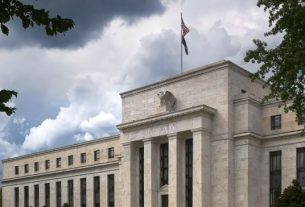|
Getting your Trinity Audio player ready...
|
Introduction
On Thursday, the Federal Reserve’s Federal Open Market Committee (FOMC) announced a quarter-point reduction in the federal funds rate, lowering it to a target range of 4.50% to 4.75%. This move, which was widely anticipated by economists and market participants, marks a significant shift in the Fed’s policy stance as it seeks to balance economic growth while managing inflationary pressures. The decision was unanimous, a notable change from the September meeting, where Michelle Bowman, a member of the Federal Reserve Board, expressed dissent, pushing back against a rate cut at the time.
1. The Federal Reserve’s Shift in Policy
The rate cut comes as the U.S. economy grapples with various challenges, including inflationary concerns, uncertain global economic conditions, and the lingering effects of the pandemic. The Fed’s decision to ease monetary policy signals a move away from the aggressive rate hikes that dominated much of 2022 and 2023, as the central bank worked to tame rising inflation.
In recent months, inflation has begun to show signs of easing, providing the Fed with some leeway to adjust its policy. However, the committee faces a delicate balancing act. While inflation remains above the central bank’s 2% target, there are concerns that overly tight monetary policy could stifle economic growth and increase unemployment.
2. Unanimous Decision but Diverging Views
The rate cut marks a return to consensus within the FOMC, a departure from the September meeting, where Michelle Bowman dissented, arguing that a rate cut would be premature given ongoing inflation risks. Bowman, who is known for her more hawkish stance on monetary policy, had pushed for keeping rates higher to ensure inflationary pressures are fully addressed.
Bowman’s dissent was a rare divergence in the Fed’s decision-making process, and many analysts saw it as a reflection of the internal debates at the Fed as officials wrestle with the challenges of managing both inflation and the health of the broader economy. In contrast, the current decision indicates a unified view among committee members that the time is right to ease policy slightly, given the cooling inflation and other economic factors.
3. The Economic Landscape: Inflation Eases, Growth Slows
The Fed’s decision to lower rates comes amid signs that inflation, which surged to 40-year highs in 2022, is slowly retreating. The Consumer Price Index (CPI) has been showing a downward trend, particularly in the last few months, suggesting that the aggressive rate hikes from previous meetings are starting to have their intended effect.
However, the broader economic picture remains mixed. While inflation has eased, economic growth has slowed, and job growth has shown signs of deceleration. Corporate earnings are under pressure, and the global economic outlook remains uncertain due to factors such as supply chain disruptions, geopolitical tensions (including the war in Ukraine), and the continued effects of COVID-19.
The U.S. labor market remains relatively strong, but with the risk of a potential recession on the horizon, the Fed is mindful of the need to support economic activity. The rate cut is a reflection of the Fed’s view that stimulating growth is essential, particularly in light of recent sluggishness in consumer spending and investment activity.
4. Impact on Borrowing and Consumer Behavior
For consumers and businesses, the Fed’s decision to lower interest rates will likely have an immediate impact on borrowing costs. With the federal funds rate reduced, interest rates on loans and mortgages are expected to follow suit, which could encourage increased borrowing and spending. This, in turn, could provide a boost to sectors like housing and automotive sales, which are sensitive to interest rate changes.
However, the rate cut is likely to have a more muted effect compared to previous cuts, as the Fed remains cautious about inflation and has indicated that it will not rush to bring rates down too quickly. The committee has stated that it intends to continue monitoring inflation and economic data to ensure that price stability remains a long-term priority.
5. Market Reactions and Forward Guidance
The Fed’s decision to lower rates has been met with mixed reactions from financial markets. On the one hand, stock markets have responded positively to the prospect of looser monetary policy, with investors hopeful that the rate cut will stimulate economic activity and corporate profits. On the other hand, some investors are wary that the Fed may be responding too quickly to economic data and could risk sparking a resurgence of inflation if it cuts rates too aggressively.
Looking ahead, the Fed’s guidance suggests that further rate cuts may be on the table in the future, but only if inflation continues to ease and economic growth remains stable. The committee remains committed to data-driven decision-making, emphasizing that it will continue to assess the economic landscape before making additional changes.
6. Global Implications of the Rate Cut
The Fed’s actions have significant implications not only for the U.S. economy but also for the global financial system. As the world’s largest economy, the United States plays a key role in shaping global economic conditions. A rate cut in the U.S. tends to affect global liquidity, impacting everything from commodity prices to capital flows.
For emerging markets, lower U.S. interest rates could provide relief in the form of easier borrowing conditions and stronger demand for exports. However, there are risks associated with the broader trend of monetary policy easing, particularly if inflationary pressures re-emerge in the U.S. or if global uncertainties, such as geopolitical conflicts, continue to affect economic stability.
Conclusion
The Federal Reserve’s decision to lower the federal funds rate by a quarter-point reflects a careful recalibration of U.S. monetary policy in response to evolving economic conditions. While inflation has shown signs of easing, the Fed remains vigilant and committed to ensuring that price stability is maintained over the long term. The unanimous decision, following a period of dissent at the September meeting, signals a renewed consensus within the FOMC as it seeks to navigate the complexities of economic growth, inflation, and global uncertainty.
As the U.S. economy continues to face both risks and opportunities, the Fed’s ongoing actions will play a pivotal role in shaping the economic landscape for years to come.
References:
- Federal Reserve Statement on Rate Decision
- Bloomberg – Fed Rate Cuts
- Reuters – U.S. Federal Reserve News



